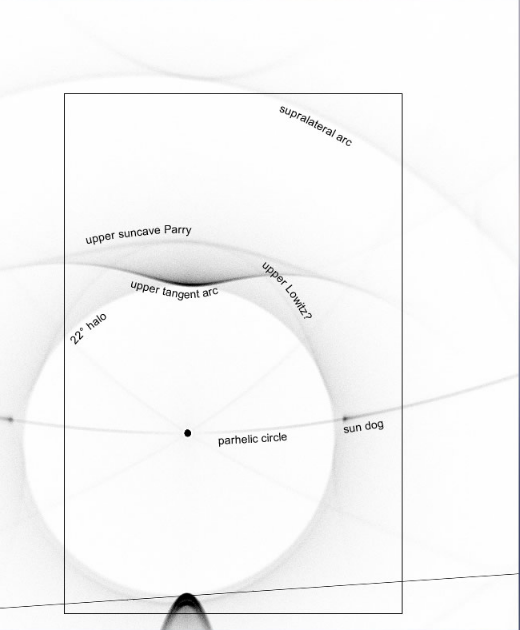California Halos
California Halos: A Fascinating Atmospheric Phenomenon
When we think of halos, our minds often conjure up images of icy landscapes and polar regions. However, the mesmerizing display of halos is not limited to these frigid environments. Even in the mild climate of California, one can witness the breathtaking beauty of halos caused by high cirrus clouds, which are typically found at altitudes of 3 to 6 miles.
Halos, although observable worldwide and throughout the year, reach their pinnacle of splendor in sub-zero temperatures with low-level diamond dust. These tiny ice crystals suspended in the atmosphere create a spectacle that captivates both scientists and sky enthusiasts alike.
The California halo display is dominated by a prominent upper tangent arc, formed by horizontally aligned column crystals. This arc, characterized by its striking appearance, adds an enchanting touch to the overall phenomenon. Additionally, the supralateral arc, seen in the top right image, is also generated by similar column crystals, showcasing a vibrant display of colors.
Among the various halo formations, the Parry arc stands out as a rare occurrence. In temperate cirrus clouds, one can expect to witness this arc once or twice a year. The Parry arc is produced by horizontally aligned column crystals, but with an additional and improbable alignment where a crystal side face becomes horizontal as well. This unique orientation efficiently produces bright and sharp halos, making the Parry arc a truly remarkable sight.
There is a tantalizing hint of another rare halo formation known as the Lowitz arc. Although its presence in the California halo display is not definitive, there appears to be a faint trace between the tangent and Parry arcs. The HaloSim ray tracing provides a visual representation of this potential Lowitz arc. However, it is important to note that Lowitz arcs are produced with much less efficiency compared to other halo formations, which explains their rarity. The HaloSim ray tracing required 20% Lowitz crystals to create the faint trace.
Traditionally oriented crystals would not produce an arc between the upper tangent arc and Parry arc without simultaneously enhancing the brightness of the 22-degree halo in the 2-3 o'clock position. In the image, this enhanced brightness is absent. Instead, the HaloSim Lowitz arc was generated by "Parry type" column crystals rocking up to 40° from horizontal in the Lowitz mode. Speculations surrounding these intriguing phenomena are both captivating and thought-provoking.
It is worth noting that in this particular display, several cloud streaks masquerade as halos, adding to the complexity of the observation. However, it is important not to draw definitive conclusions based on a single image. While it is likely that the "Lowitz arc" was one of these streaks, it does not diminish the marvel and wonder of the halos observed in California.
The study and documentation of atmospheric optics, such as the California halos, continue to fascinate scientists and sky enthusiasts alike. Each new observation provides valuable insights into the intricate workings of our atmosphere and the mesmerizing beauty it can create. As we delve deeper into understanding these phenomena, we uncover the true wonders of our natural world.

California Halos - Seen at Oakland by Alexandra Childs (ARTSS) on January 3, 2009. ©Alexandra Childs, shown with permission.
Splendid halos do not need Polar weather, 3- 6 mile high cirrus cloud over mild California is cold enough to hold halo generating ice crystals.

Halos can be seen anywhere in the world at any season but it must be admitted that most of the very best are those in the low level diamond dust of sub-zero temperatures.
A strong upper tangent arc generated by horizontal column crystals dominates the display. Similar column crystals produced the colourful supralateral arc just in the image at top right.
A rare Parry arc - expect to see one or two times a year in temperate cirrus cloud - tops the tangent arc. Parry arcs also come from horizontally aligned column crystals but the crystals have to be additionally and improbably aligned so that a crystal side face is horizontal too. The Parry orientation is very efficient indeed at producing bright, sharp halos otherwise we would probably almost never see them.
Is there an extremely rare Lowitz arc?
There is a hint of a halo between the tangent and Parry arcs in just the position of an upper Lowitz arc. The accompanying HaloSim ray tracing shows it.
Unlike Parry arcs, Lowitz arcs are produced very inefficiently indeed which probably accounts much for their rarity. The HaloSim ray tracing needed 20% Lowitz crystals to produce the faint trace.
There is another twist. Traditionally oriented crystals would not give an arc between the UTA and Parry without producing enhanced brightness on the 22-degree halo in the 2-3 o'clock position. The latter is not seen in the image. The HaloSim Lowitz arc was instead made by ' Parry type' column crystals rocking up to 40� from horizontal in the Lowitz mode. Speculations like these are interesting to pursue but....
In this display several rather beautiful cloud streaks masquerade as halos. It is dangerous to speculate over much from one image. Likely the 'Lowitz arc' was one of the streaks but that does not detract from the marvel of the halos.
Note: this article has been automatically converted from the old site and may not appear as intended. You can find the original article here.
Reference Atmospheric Optics
If you use any of the definitions, information, or data presented on Atmospheric Optics, please copy the link or reference below to properly credit us as the reference source. Thank you!
-
<a href="https://atoptics.co.uk/blog/california-halos/">California Halos</a>
-
"California Halos". Atmospheric Optics. Accessed on November 26, 2024. https://atoptics.co.uk/blog/california-halos/.
-
"California Halos". Atmospheric Optics, https://atoptics.co.uk/blog/california-halos/. Accessed 26 November, 2024
-
California Halos. Atmospheric Optics. Retrieved from https://atoptics.co.uk/blog/california-halos/.